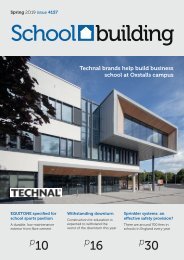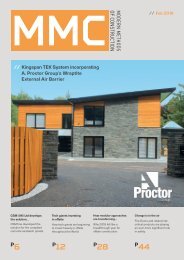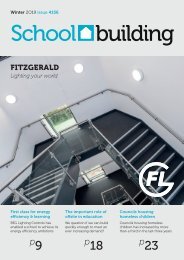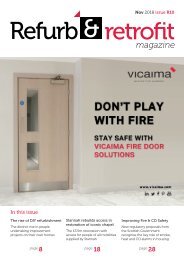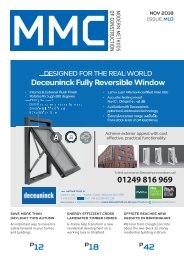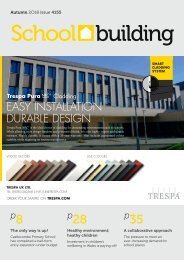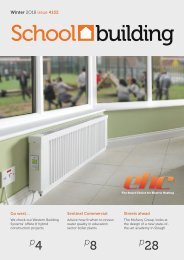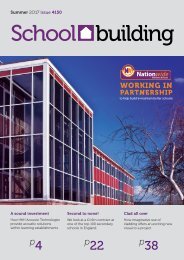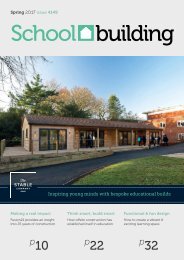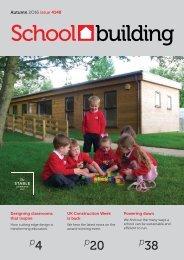R1 R&R Sept '16 52 cc
You also want an ePaper? Increase the reach of your titles
YUMPU automatically turns print PDFs into web optimized ePapers that Google loves.
Industry Voice<br />
Warming to sustainability<br />
Older housing stock frequently has inadequate or non-existent insulation and few energy efficient appliances. We speak with<br />
Brody Isaac, the Sustainability Manager for Viridian Housing, about his organisation’s approach to improving housing standards.<br />
“If ventilation is not<br />
considered when<br />
improving the thermal and<br />
airtight efficiency of a<br />
property, damp and mould<br />
growth are nearly certain<br />
to crop up in a later year, if<br />
not immediately.“<br />
Brody Isaac<br />
R&R: What projects have you recently been<br />
involved with that included retrofitting<br />
energy efficiency products and services?<br />
Brody: Viridian has been involved with several<br />
energy efficiency programmes from draft<br />
proofing to external wall insulation, all with the<br />
aim of improving the housing standard of our<br />
properties.<br />
Since the autumn of 2015, we have carried out<br />
cavity insulation in 383 homes which had<br />
been built in the 1990s and only had partial<br />
cavity fill. This work was funded via ECO.<br />
Over the past year we have carried out draft<br />
proofing and secondary glazing in over 150 of<br />
our properties to improve their thermal<br />
performance, and to give our residents some<br />
added comfort.<br />
We have also recently procured an external<br />
wall insulation (EWI), cavity wall and loft<br />
insulation contract. With this, we aim to focus<br />
on our lowest energy performing properties.<br />
This will include providing EWI to 300 homes<br />
as well as 1000 cavity wall installations and<br />
1000 loft insulations jobs.<br />
R&R: What are the types of<br />
products/services you usually install?<br />
Brody: Our product of choice for cavity<br />
insulation is a blown bead insulation system.<br />
The external wall insulation uses EPS<br />
expanded polyester boards. Our secondary<br />
glazing is produced by a bespoke system,<br />
which uses magnets and polycarbonate<br />
plastic. The process creates value for money<br />
by driving down costs.<br />
R&R: How were these projects funded?<br />
Brody: Our cavity wall insulation contract,<br />
worth approximately £250k, was funded via<br />
ECO.<br />
The EWI, cavity wall and loft insulation<br />
contract has been funded completely by<br />
Viridian as part of our commitment to<br />
improving our homes and the lives of our<br />
customers.<br />
R&R: What funding/encouragement would<br />
you like to see made available to encourage<br />
RSLs/householders to improve energy<br />
efficiency to save money (and resources)?<br />
Brody: Housing associations should be<br />
allowed to increase rental income on homes<br />
where retrofit works have been undertaken;<br />
we would like to partially fund these over a 10-<br />
year period, based on a proportion of the<br />
energy savings.<br />
Also, corner junctions and edges are tricky<br />
aspects with EWI but there’s not enough detail<br />
about this in the design guidance. Having<br />
tighter design guidance in the new PAS2030<br />
specification will help highlight the calculated<br />
savings in both pounds and carbon. Making<br />
these changes will tackle below-standard work<br />
by ensuring only the best quality of work is<br />
approved and best practice is adopted.<br />
Funding mechanisms, such as ECO, are<br />
currently focused on the quantity rather than<br />
the quality of the work. This can mean that<br />
poor quality jobs are approved and, as a result,<br />
it puts the industry off the idea of retrofit<br />
because it’s seen as a high technical risk. If the<br />
quality of the overall work was improved,<br />
confidence would be improved. As the<br />
majority of the UK’s worst performing<br />
residential properties are solid wall and F & G<br />
SAP rated, solid wall insulation certainly needs<br />
to be more attractive.<br />
The main constraints to low energy retrofit<br />
projects, like many others, are time and<br />
money. Where funding has been made<br />
available it usually dictates the time frames<br />
and how much money can be spent per<br />
property. This has multiple knock-on negative<br />
effects. For example, choosing a cheaper and<br />
quicker option can cause problems in the<br />
years to come. A key example of this is<br />
ventilation with solid wall insulation for both<br />
EWI and external wall insulation.<br />
If ventilation is not considered when<br />
improving the thermal and airtight efficiency<br />
of a property, damp and mould growth are<br />
nearly certain to crop up in a later year, if not<br />
immediately. This has negative impacts for the<br />
tenant in the property, decreasing their<br />
standard of living and putting their health at<br />
Continued on page 16...<br />
14 Refurb retrofit<br />
magazine<br />
Sep/Oct 2016 <strong>R1</strong>



